-
EXECUTIVE SUMMARY
-
Market Overview
-
Key Findings
-
Market Segmentation
-
Competitive Landscape
-
Challenges and Opportunities
-
Future Outlook
-
MARKET INTRODUCTION
-
Definition
-
Scope of the study
- Research Objective
- Assumption
- Limitations
-
RESEARCH METHODOLOGY
-
Overview
-
Data Mining
-
Secondary Research
-
Primary Research
- Primary Interviews and Information Gathering Process
- Breakdown of Primary Respondents
-
Forecasting Model
-
Market Size Estimation
- Bottom-Up Approach
- Top-Down Approach
-
Data Triangulation
-
Validation
-
MARKET DYNAMICS
-
Overview
-
Drivers
-
Restraints
-
Opportunities
-
MARKET FACTOR ANALYSIS
-
Value chain Analysis
-
Porter's Five Forces Analysis
- Bargaining Power of Suppliers
- Bargaining Power of Buyers
- Threat of New Entrants
- Threat of Substitutes
- Intensity of Rivalry
-
COVID-19 Impact Analysis
- Market Impact Analysis
- Regional Impact
- Opportunity and Threat Analysis
-
Ambient Food Packaging Market, BY Material Type (USD Billion)
-
Plastic
-
Paperboard
-
Metal
-
Glass
-
Ambient Food Packaging Market, BY Product Type (USD Billion)
-
Bottles
-
Pouches
-
Cans
-
Trays
-
Ambient Food Packaging Market, BY Technology (USD Billion)
-
Flexible Packaging
-
Rigid Packaging
-
Semi-Rigid Packaging
-
Ambient Food Packaging Market, BY End Use (USD Billion)
-
Food
-
Beverages
-
Snacks
-
Dairy
-
Ambient Food Packaging Market, BY Regional (USD Billion)
-
North America
- US
- Canada
-
Europe
- Germany
- UK
- France
- Russia
- Italy
- Spain
- Rest of Europe
-
APAC
- China
- India
- Japan
- South Korea
- Malaysia
- Thailand
- Indonesia
- Rest of APAC
-
South America
- Brazil
- Mexico
- Argentina
- Rest of South America
-
MEA
- GCC Countries
- South Africa
- Rest of MEA
-
Competitive Landscape
-
Overview
-
Competitive Analysis
-
Market share Analysis
-
Major Growth Strategy in the Ambient Food Packaging Market
-
Competitive Benchmarking
-
Leading Players in Terms of Number of Developments in the Ambient Food Packaging Market
-
Key developments and growth strategies
- New Product Launch/Service Deployment
- Merger & Acquisitions
- Joint Ventures
-
Major Players Financial Matrix
- Sales and Operating Income
- Major Players R&D Expenditure. 2023
-
Company Profiles
-
Sappi
- Financial Overview
- Products Offered
- Key Developments
- SWOT Analysis
- Key Strategies
-
Clondalkin Group
- Financial Overview
- Products Offered
- Key Developments
- SWOT Analysis
- Key Strategies
-
ProAmpac
- Financial Overview
- Products Offered
- Key Developments
- SWOT Analysis
- Key Strategies
-
Ball Corporation
- Financial Overview
- Products Offered
- Key Developments
- SWOT Analysis
- Key Strategies
-
Grafica Flexo
- Financial Overview
- Products Offered
- Key Developments
- SWOT Analysis
- Key Strategies
-
Sealed Air
- Financial Overview
- Products Offered
- Key Developments
- SWOT Analysis
- Key Strategies
-
Stora Enso
- Financial Overview
- Products Offered
- Key Developments
- SWOT Analysis
- Key Strategies
-
Avery Dennison
- Financial Overview
- Products Offered
- Key Developments
- SWOT Analysis
- Key Strategies
-
Amcor
- Financial Overview
- Products Offered
- Key Developments
- SWOT Analysis
- Key Strategies
-
Crown Holdings
- Financial Overview
- Products Offered
- Key Developments
- SWOT Analysis
- Key Strategies
-
WestRock
- Financial Overview
- Products Offered
- Key Developments
- SWOT Analysis
- Key Strategies
-
Berry Global
- Financial Overview
- Products Offered
- Key Developments
- SWOT Analysis
- Key Strategies
-
Smurfit Kappa
- Financial Overview
- Products Offered
- Key Developments
- SWOT Analysis
- Key Strategies
-
Mondi
- Financial Overview
- Products Offered
- Key Developments
- SWOT Analysis
- Key Strategies
-
Tetra Pak
- Financial Overview
- Products Offered
- Key Developments
- SWOT Analysis
- Key Strategies
-
Appendix
-
References
-
Related Reports
-
LIST Of tables
-
LIST OF ASSUMPTIONS
-
North America Ambient Food Packaging Market SIZE ESTIMATES & FORECAST, BY MATERIAL TYPE, 2019-2032 (USD Billions)
-
North America Ambient Food Packaging Market SIZE ESTIMATES & FORECAST, BY PRODUCT TYPE, 2019-2032 (USD Billions)
-
North America Ambient Food Packaging Market SIZE ESTIMATES & FORECAST, BY TECHNOLOGY, 2019-2032 (USD Billions)
-
North America Ambient Food Packaging Market SIZE ESTIMATES & FORECAST, BY END USE, 2019-2032 (USD Billions)
-
North America Ambient Food Packaging Market SIZE ESTIMATES & FORECAST, BY REGIONAL, 2019-2032 (USD Billions)
-
US Ambient Food Packaging Market SIZE ESTIMATES & FORECAST, BY MATERIAL TYPE, 2019-2032 (USD Billions)
-
US Ambient Food Packaging Market SIZE ESTIMATES & FORECAST, BY PRODUCT TYPE, 2019-2032 (USD Billions)
-
US Ambient Food Packaging Market SIZE ESTIMATES & FORECAST, BY TECHNOLOGY, 2019-2032 (USD Billions)
-
US Ambient Food Packaging Market SIZE ESTIMATES & FORECAST, BY END USE, 2019-2032 (USD Billions)
-
US Ambient Food Packaging Market SIZE ESTIMATES & FORECAST, BY REGIONAL, 2019-2032 (USD Billions)
-
Canada Ambient Food Packaging Market SIZE ESTIMATES & FORECAST, BY MATERIAL TYPE, 2019-2032 (USD Billions)
-
Canada Ambient Food Packaging Market SIZE ESTIMATES & FORECAST, BY PRODUCT TYPE, 2019-2032 (USD Billions)
-
Canada Ambient Food Packaging Market SIZE ESTIMATES & FORECAST, BY TECHNOLOGY, 2019-2032 (USD Billions)
-
Canada Ambient Food Packaging Market SIZE ESTIMATES & FORECAST, BY END USE, 2019-2032 (USD Billions)
-
Canada Ambient Food Packaging Market SIZE ESTIMATES & FORECAST, BY REGIONAL, 2019-2032 (USD Billions)
-
Europe Ambient Food Packaging Market SIZE ESTIMATES & FORECAST, BY MATERIAL TYPE, 2019-2032 (USD Billions)
-
Europe Ambient Food Packaging Market SIZE ESTIMATES & FORECAST, BY PRODUCT TYPE, 2019-2032 (USD Billions)
-
Europe Ambient Food Packaging Market SIZE ESTIMATES & FORECAST, BY TECHNOLOGY, 2019-2032 (USD Billions)
-
Europe Ambient Food Packaging Market SIZE ESTIMATES & FORECAST, BY END USE, 2019-2032 (USD Billions)
-
Europe Ambient Food Packaging Market SIZE ESTIMATES & FORECAST, BY REGIONAL, 2019-2032 (USD Billions)
-
Germany Ambient Food Packaging Market SIZE ESTIMATES & FORECAST, BY MATERIAL TYPE, 2019-2032 (USD Billions)
-
Germany Ambient Food Packaging Market SIZE ESTIMATES & FORECAST, BY PRODUCT TYPE, 2019-2032 (USD Billions)
-
Germany Ambient Food Packaging Market SIZE ESTIMATES & FORECAST, BY TECHNOLOGY, 2019-2032 (USD Billions)
-
Germany Ambient Food Packaging Market SIZE ESTIMATES & FORECAST, BY END USE, 2019-2032 (USD Billions)
-
Germany Ambient Food Packaging Market SIZE ESTIMATES & FORECAST, BY REGIONAL, 2019-2032 (USD Billions)
-
UK Ambient Food Packaging Market SIZE ESTIMATES & FORECAST, BY MATERIAL TYPE, 2019-2032 (USD Billions)
-
UK Ambient Food Packaging Market SIZE ESTIMATES & FORECAST, BY PRODUCT TYPE, 2019-2032 (USD Billions)
-
UK Ambient Food Packaging Market SIZE ESTIMATES & FORECAST, BY TECHNOLOGY, 2019-2032 (USD Billions)
-
UK Ambient Food Packaging Market SIZE ESTIMATES & FORECAST, BY END USE, 2019-2032 (USD Billions)
-
UK Ambient Food Packaging Market SIZE ESTIMATES & FORECAST, BY REGIONAL, 2019-2032 (USD Billions)
-
France Ambient Food Packaging Market SIZE ESTIMATES & FORECAST, BY MATERIAL TYPE, 2019-2032 (USD Billions)
-
France Ambient Food Packaging Market SIZE ESTIMATES & FORECAST, BY PRODUCT TYPE, 2019-2032 (USD Billions)
-
France Ambient Food Packaging Market SIZE ESTIMATES & FORECAST, BY TECHNOLOGY, 2019-2032 (USD Billions)
-
France Ambient Food Packaging Market SIZE ESTIMATES & FORECAST, BY END USE, 2019-2032 (USD Billions)
-
France Ambient Food Packaging Market SIZE ESTIMATES & FORECAST, BY REGIONAL, 2019-2032 (USD Billions)
-
Russia Ambient Food Packaging Market SIZE ESTIMATES & FORECAST, BY MATERIAL TYPE, 2019-2032 (USD Billions)
-
Russia Ambient Food Packaging Market SIZE ESTIMATES & FORECAST, BY PRODUCT TYPE, 2019-2032 (USD Billions)
-
Russia Ambient Food Packaging Market SIZE ESTIMATES & FORECAST, BY TECHNOLOGY, 2019-2032 (USD Billions)
-
Russia Ambient Food Packaging Market SIZE ESTIMATES & FORECAST, BY END USE, 2019-2032 (USD Billions)
-
Russia Ambient Food Packaging Market SIZE ESTIMATES & FORECAST, BY REGIONAL, 2019-2032 (USD Billions)
-
Italy Ambient Food Packaging Market SIZE ESTIMATES & FORECAST, BY MATERIAL TYPE, 2019-2032 (USD Billions)
-
Italy Ambient Food Packaging Market SIZE ESTIMATES & FORECAST, BY PRODUCT TYPE, 2019-2032 (USD Billions)
-
Italy Ambient Food Packaging Market SIZE ESTIMATES & FORECAST, BY TECHNOLOGY, 2019-2032 (USD Billions)
-
Italy Ambient Food Packaging Market SIZE ESTIMATES & FORECAST, BY END USE, 2019-2032 (USD Billions)
-
Italy Ambient Food Packaging Market SIZE ESTIMATES & FORECAST, BY REGIONAL, 2019-2032 (USD Billions)
-
Spain Ambient Food Packaging Market SIZE ESTIMATES & FORECAST, BY MATERIAL TYPE, 2019-2032 (USD Billions)
-
Spain Ambient Food Packaging Market SIZE ESTIMATES & FORECAST, BY PRODUCT TYPE, 2019-2032 (USD Billions)
-
Spain Ambient Food Packaging Market SIZE ESTIMATES & FORECAST, BY TECHNOLOGY, 2019-2032 (USD Billions)
-
Spain Ambient Food Packaging Market SIZE ESTIMATES & FORECAST, BY END USE, 2019-2032 (USD Billions)
-
Spain Ambient Food Packaging Market SIZE ESTIMATES & FORECAST, BY REGIONAL, 2019-2032 (USD Billions)
-
Rest of Europe Ambient Food Packaging Market SIZE ESTIMATES & FORECAST, BY MATERIAL TYPE, 2019-2032 (USD Billions)
-
Rest of Europe Ambient Food Packaging Market SIZE ESTIMATES & FORECAST, BY PRODUCT TYPE, 2019-2032 (USD Billions)
-
Rest of Europe Ambient Food Packaging Market SIZE ESTIMATES & FORECAST, BY TECHNOLOGY, 2019-2032 (USD Billions)
-
Rest of Europe Ambient Food Packaging Market SIZE ESTIMATES & FORECAST, BY END USE, 2019-2032 (USD Billions)
-
Rest of Europe Ambient Food Packaging Market SIZE ESTIMATES & FORECAST, BY REGIONAL, 2019-2032 (USD Billions)
-
APAC Ambient Food Packaging Market SIZE ESTIMATES & FORECAST, BY MATERIAL TYPE, 2019-2032 (USD Billions)
-
APAC Ambient Food Packaging Market SIZE ESTIMATES & FORECAST, BY PRODUCT TYPE, 2019-2032 (USD Billions)
-
APAC Ambient Food Packaging Market SIZE ESTIMATES & FORECAST, BY TECHNOLOGY, 2019-2032 (USD Billions)
-
APAC Ambient Food Packaging Market SIZE ESTIMATES & FORECAST, BY END USE, 2019-2032 (USD Billions)
-
APAC Ambient Food Packaging Market SIZE ESTIMATES & FORECAST, BY REGIONAL, 2019-2032 (USD Billions)
-
China Ambient Food Packaging Market SIZE ESTIMATES & FORECAST, BY MATERIAL TYPE, 2019-2032 (USD Billions)
-
China Ambient Food Packaging Market SIZE ESTIMATES & FORECAST, BY PRODUCT TYPE, 2019-2032 (USD Billions)
-
China Ambient Food Packaging Market SIZE ESTIMATES & FORECAST, BY TECHNOLOGY, 2019-2032 (USD Billions)
-
China Ambient Food Packaging Market SIZE ESTIMATES & FORECAST, BY END USE, 2019-2032 (USD Billions)
-
China Ambient Food Packaging Market SIZE ESTIMATES & FORECAST, BY REGIONAL, 2019-2032 (USD Billions)
-
India Ambient Food Packaging Market SIZE ESTIMATES & FORECAST, BY MATERIAL TYPE, 2019-2032 (USD Billions)
-
India Ambient Food Packaging Market SIZE ESTIMATES & FORECAST, BY PRODUCT TYPE, 2019-2032 (USD Billions)
-
India Ambient Food Packaging Market SIZE ESTIMATES & FORECAST, BY TECHNOLOGY, 2019-2032 (USD Billions)
-
India Ambient Food Packaging Market SIZE ESTIMATES & FORECAST, BY END USE, 2019-2032 (USD Billions)
-
India Ambient Food Packaging Market SIZE ESTIMATES & FORECAST, BY REGIONAL, 2019-2032 (USD Billions)
-
Japan Ambient Food Packaging Market SIZE ESTIMATES & FORECAST, BY MATERIAL TYPE, 2019-2032 (USD Billions)
-
Japan Ambient Food Packaging Market SIZE ESTIMATES & FORECAST, BY PRODUCT TYPE, 2019-2032 (USD Billions)
-
Japan Ambient Food Packaging Market SIZE ESTIMATES & FORECAST, BY TECHNOLOGY, 2019-2032 (USD Billions)
-
Japan Ambient Food Packaging Market SIZE ESTIMATES & FORECAST, BY END USE, 2019-2032 (USD Billions)
-
Japan Ambient Food Packaging Market SIZE ESTIMATES & FORECAST, BY REGIONAL, 2019-2032 (USD Billions)
-
South Korea Ambient Food Packaging Market SIZE ESTIMATES & FORECAST, BY MATERIAL TYPE, 2019-2032 (USD Billions)
-
South Korea Ambient Food Packaging Market SIZE ESTIMATES & FORECAST, BY PRODUCT TYPE, 2019-2032 (USD Billions)
-
South Korea Ambient Food Packaging Market SIZE ESTIMATES & FORECAST, BY TECHNOLOGY, 2019-2032 (USD Billions)
-
South Korea Ambient Food Packaging Market SIZE ESTIMATES & FORECAST, BY END USE, 2019-2032 (USD Billions)
-
South Korea Ambient Food Packaging Market SIZE ESTIMATES & FORECAST, BY REGIONAL, 2019-2032 (USD Billions)
-
Malaysia Ambient Food Packaging Market SIZE ESTIMATES & FORECAST, BY MATERIAL TYPE, 2019-2032 (USD Billions)
-
Malaysia Ambient Food Packaging Market SIZE ESTIMATES & FORECAST, BY PRODUCT TYPE, 2019-2032 (USD Billions)
-
Malaysia Ambient Food Packaging Market SIZE ESTIMATES & FORECAST, BY TECHNOLOGY, 2019-2032 (USD Billions)
-
Malaysia Ambient Food Packaging Market SIZE ESTIMATES & FORECAST, BY END USE, 2019-2032 (USD Billions)
-
Malaysia Ambient Food Packaging Market SIZE ESTIMATES & FORECAST, BY REGIONAL, 2019-2032 (USD Billions)
-
Thailand Ambient Food Packaging Market SIZE ESTIMATES & FORECAST, BY MATERIAL TYPE, 2019-2032 (USD Billions)
-
Thailand Ambient Food Packaging Market SIZE ESTIMATES & FORECAST, BY PRODUCT TYPE, 2019-2032 (USD Billions)
-
Thailand Ambient Food Packaging Market SIZE ESTIMATES & FORECAST, BY TECHNOLOGY, 2019-2032 (USD Billions)
-
Thailand Ambient Food Packaging Market SIZE ESTIMATES & FORECAST, BY END USE, 2019-2032 (USD Billions)
-
Thailand Ambient Food Packaging Market SIZE ESTIMATES & FORECAST, BY REGIONAL, 2019-2032 (USD Billions)
-
Indonesia Ambient Food Packaging Market SIZE ESTIMATES & FORECAST, BY MATERIAL TYPE, 2019-2032 (USD Billions)
-
Indonesia Ambient Food Packaging Market SIZE ESTIMATES & FORECAST, BY PRODUCT TYPE, 2019-2032 (USD Billions)
-
Indonesia Ambient Food Packaging Market SIZE ESTIMATES & FORECAST, BY TECHNOLOGY, 2019-2032 (USD Billions)
-
Indonesia Ambient Food Packaging Market SIZE ESTIMATES & FORECAST, BY END USE, 2019-2032 (USD Billions)
-
Indonesia Ambient Food Packaging Market SIZE ESTIMATES & FORECAST, BY REGIONAL, 2019-2032 (USD Billions)
-
Rest of APAC Ambient Food Packaging Market SIZE ESTIMATES & FORECAST, BY MATERIAL TYPE, 2019-2032 (USD Billions)
-
Rest of APAC Ambient Food Packaging Market SIZE ESTIMATES & FORECAST, BY PRODUCT TYPE, 2019-2032 (USD Billions)
-
Rest of APAC Ambient Food Packaging Market SIZE ESTIMATES & FORECAST, BY TECHNOLOGY, 2019-2032 (USD Billions)
-
Rest of APAC Ambient Food Packaging Market SIZE ESTIMATES & FORECAST, BY END USE, 2019-2032 (USD Billions)
-
Rest of APAC Ambient Food Packaging Market SIZE ESTIMATES & FORECAST, BY REGIONAL, 2019-2032 (USD Billions)
-
South America Ambient Food Packaging Market SIZE ESTIMATES & FORECAST, BY MATERIAL TYPE, 2019-2032 (USD Billions)
-
South America Ambient Food Packaging Market SIZE ESTIMATES & FORECAST, BY PRODUCT TYPE, 2019-2032 (USD Billions)
-
South America Ambient Food Packaging Market SIZE ESTIMATES & FORECAST, BY TECHNOLOGY, 2019-2032 (USD Billions)
-
South America Ambient Food Packaging Market SIZE ESTIMATES & FORECAST, BY END USE, 2019-2032 (USD Billions)
-
South America Ambient Food Packaging Market SIZE ESTIMATES & FORECAST, BY REGIONAL, 2019-2032 (USD Billions)
-
Brazil Ambient Food Packaging Market SIZE ESTIMATES & FORECAST, BY MATERIAL TYPE, 2019-2032 (USD Billions)
-
Brazil Ambient Food Packaging Market SIZE ESTIMATES & FORECAST, BY PRODUCT TYPE, 2019-2032 (USD Billions)
-
Brazil Ambient Food Packaging Market SIZE ESTIMATES & FORECAST, BY TECHNOLOGY, 2019-2032 (USD Billions)
-
Brazil Ambient Food Packaging Market SIZE ESTIMATES & FORECAST, BY END USE, 2019-2032 (USD Billions)
-
Brazil Ambient Food Packaging Market SIZE ESTIMATES & FORECAST, BY REGIONAL, 2019-2032 (USD Billions)
-
Mexico Ambient Food Packaging Market SIZE ESTIMATES & FORECAST, BY MATERIAL TYPE, 2019-2032 (USD Billions)
-
Mexico Ambient Food Packaging Market SIZE ESTIMATES & FORECAST, BY PRODUCT TYPE, 2019-2032 (USD Billions)
-
Mexico Ambient Food Packaging Market SIZE ESTIMATES & FORECAST, BY TECHNOLOGY, 2019-2032 (USD Billions)
-
Mexico Ambient Food Packaging Market SIZE ESTIMATES & FORECAST, BY END USE, 2019-2032 (USD Billions)
-
Mexico Ambient Food Packaging Market SIZE ESTIMATES & FORECAST, BY REGIONAL, 2019-2032 (USD Billions)
-
Argentina Ambient Food Packaging Market SIZE ESTIMATES & FORECAST, BY MATERIAL TYPE, 2019-2032 (USD Billions)
-
Argentina Ambient Food Packaging Market SIZE ESTIMATES & FORECAST, BY PRODUCT TYPE, 2019-2032 (USD Billions)
-
Argentina Ambient Food Packaging Market SIZE ESTIMATES & FORECAST, BY TECHNOLOGY, 2019-2032 (USD Billions)
-
Argentina Ambient Food Packaging Market SIZE ESTIMATES & FORECAST, BY END USE, 2019-2032 (USD Billions)
-
Argentina Ambient Food Packaging Market SIZE ESTIMATES & FORECAST, BY REGIONAL, 2019-2032 (USD Billions)
-
Rest of South America Ambient Food Packaging Market SIZE ESTIMATES & FORECAST, BY MATERIAL TYPE, 2019-2032 (USD Billions)
-
Rest of South America Ambient Food Packaging Market SIZE ESTIMATES & FORECAST, BY PRODUCT TYPE, 2019-2032 (USD Billions)
-
Rest of South America Ambient Food Packaging Market SIZE ESTIMATES & FORECAST, BY TECHNOLOGY, 2019-2032 (USD Billions)
-
Rest of South America Ambient Food Packaging Market SIZE ESTIMATES & FORECAST, BY END USE, 2019-2032 (USD Billions)
-
Rest of South America Ambient Food Packaging Market SIZE ESTIMATES & FORECAST, BY REGIONAL, 2019-2032 (USD Billions)
-
MEA Ambient Food Packaging Market SIZE ESTIMATES & FORECAST, BY MATERIAL TYPE, 2019-2032 (USD Billions)
-
MEA Ambient Food Packaging Market SIZE ESTIMATES & FORECAST, BY PRODUCT TYPE, 2019-2032 (USD Billions)
-
MEA Ambient Food Packaging Market SIZE ESTIMATES & FORECAST, BY TECHNOLOGY, 2019-2032 (USD Billions)
-
MEA Ambient Food Packaging Market SIZE ESTIMATES & FORECAST, BY END USE, 2019-2032 (USD Billions)
-
MEA Ambient Food Packaging Market SIZE ESTIMATES & FORECAST, BY REGIONAL, 2019-2032 (USD Billions)
-
GCC Countries Ambient Food Packaging Market SIZE ESTIMATES & FORECAST, BY MATERIAL TYPE, 2019-2032 (USD Billions)
-
GCC Countries Ambient Food Packaging Market SIZE ESTIMATES & FORECAST, BY PRODUCT TYPE, 2019-2032 (USD Billions)
-
GCC Countries Ambient Food Packaging Market SIZE ESTIMATES & FORECAST, BY TECHNOLOGY, 2019-2032 (USD Billions)
-
GCC Countries Ambient Food Packaging Market SIZE ESTIMATES & FORECAST, BY END USE, 2019-2032 (USD Billions)
-
GCC Countries Ambient Food Packaging Market SIZE ESTIMATES & FORECAST, BY REGIONAL, 2019-2032 (USD Billions)
-
South Africa Ambient Food Packaging Market SIZE ESTIMATES & FORECAST, BY MATERIAL TYPE, 2019-2032 (USD Billions)
-
South Africa Ambient Food Packaging Market SIZE ESTIMATES & FORECAST, BY PRODUCT TYPE, 2019-2032 (USD Billions)
-
South Africa Ambient Food Packaging Market SIZE ESTIMATES & FORECAST, BY TECHNOLOGY, 2019-2032 (USD Billions)
-
South Africa Ambient Food Packaging Market SIZE ESTIMATES & FORECAST, BY END USE, 2019-2032 (USD Billions)
-
South Africa Ambient Food Packaging Market SIZE ESTIMATES & FORECAST, BY REGIONAL, 2019-2032 (USD Billions)
-
Rest of MEA Ambient Food Packaging Market SIZE ESTIMATES & FORECAST, BY MATERIAL TYPE, 2019-2032 (USD Billions)
-
Rest of MEA Ambient Food Packaging Market SIZE ESTIMATES & FORECAST, BY PRODUCT TYPE, 2019-2032 (USD Billions)
-
Rest of MEA Ambient Food Packaging Market SIZE ESTIMATES & FORECAST, BY TECHNOLOGY, 2019-2032 (USD Billions)
-
Rest of MEA Ambient Food Packaging Market SIZE ESTIMATES & FORECAST, BY END USE, 2019-2032 (USD Billions)
-
Rest of MEA Ambient Food Packaging Market SIZE ESTIMATES & FORECAST, BY REGIONAL, 2019-2032 (USD Billions)
-
PRODUCT LAUNCH/PRODUCT DEVELOPMENT/APPROVAL
-
ACQUISITION/PARTNERSHIP
-
LIST Of figures
-
MARKET SYNOPSIS
-
NORTH AMERICA AMBIENT FOOD PACKAGING MARKET ANALYSIS
-
US AMBIENT FOOD PACKAGING MARKET ANALYSIS BY MATERIAL TYPE
-
US AMBIENT FOOD PACKAGING MARKET ANALYSIS BY PRODUCT TYPE
-
US AMBIENT FOOD PACKAGING MARKET ANALYSIS BY TECHNOLOGY
-
US AMBIENT FOOD PACKAGING MARKET ANALYSIS BY END USE
-
US AMBIENT FOOD PACKAGING MARKET ANALYSIS BY REGIONAL
-
CANADA AMBIENT FOOD PACKAGING MARKET ANALYSIS BY MATERIAL TYPE
-
CANADA AMBIENT FOOD PACKAGING MARKET ANALYSIS BY PRODUCT TYPE
-
CANADA AMBIENT FOOD PACKAGING MARKET ANALYSIS BY TECHNOLOGY
-
CANADA AMBIENT FOOD PACKAGING MARKET ANALYSIS BY END USE
-
CANADA AMBIENT FOOD PACKAGING MARKET ANALYSIS BY REGIONAL
-
EUROPE AMBIENT FOOD PACKAGING MARKET ANALYSIS
-
GERMANY AMBIENT FOOD PACKAGING MARKET ANALYSIS BY MATERIAL TYPE
-
GERMANY AMBIENT FOOD PACKAGING MARKET ANALYSIS BY PRODUCT TYPE
-
GERMANY AMBIENT FOOD PACKAGING MARKET ANALYSIS BY TECHNOLOGY
-
GERMANY AMBIENT FOOD PACKAGING MARKET ANALYSIS BY END USE
-
GERMANY AMBIENT FOOD PACKAGING MARKET ANALYSIS BY REGIONAL
-
UK AMBIENT FOOD PACKAGING MARKET ANALYSIS BY MATERIAL TYPE
-
UK AMBIENT FOOD PACKAGING MARKET ANALYSIS BY PRODUCT TYPE
-
UK AMBIENT FOOD PACKAGING MARKET ANALYSIS BY TECHNOLOGY
-
UK AMBIENT FOOD PACKAGING MARKET ANALYSIS BY END USE
-
UK AMBIENT FOOD PACKAGING MARKET ANALYSIS BY REGIONAL
-
FRANCE AMBIENT FOOD PACKAGING MARKET ANALYSIS BY MATERIAL TYPE
-
FRANCE AMBIENT FOOD PACKAGING MARKET ANALYSIS BY PRODUCT TYPE
-
FRANCE AMBIENT FOOD PACKAGING MARKET ANALYSIS BY TECHNOLOGY
-
FRANCE AMBIENT FOOD PACKAGING MARKET ANALYSIS BY END USE
-
FRANCE AMBIENT FOOD PACKAGING MARKET ANALYSIS BY REGIONAL
-
RUSSIA AMBIENT FOOD PACKAGING MARKET ANALYSIS BY MATERIAL TYPE
-
RUSSIA AMBIENT FOOD PACKAGING MARKET ANALYSIS BY PRODUCT TYPE
-
RUSSIA AMBIENT FOOD PACKAGING MARKET ANALYSIS BY TECHNOLOGY
-
RUSSIA AMBIENT FOOD PACKAGING MARKET ANALYSIS BY END USE
-
RUSSIA AMBIENT FOOD PACKAGING MARKET ANALYSIS BY REGIONAL
-
ITALY AMBIENT FOOD PACKAGING MARKET ANALYSIS BY MATERIAL TYPE
-
ITALY AMBIENT FOOD PACKAGING MARKET ANALYSIS BY PRODUCT TYPE
-
ITALY AMBIENT FOOD PACKAGING MARKET ANALYSIS BY TECHNOLOGY
-
ITALY AMBIENT FOOD PACKAGING MARKET ANALYSIS BY END USE
-
ITALY AMBIENT FOOD PACKAGING MARKET ANALYSIS BY REGIONAL
-
SPAIN AMBIENT FOOD PACKAGING MARKET ANALYSIS BY MATERIAL TYPE
-
SPAIN AMBIENT FOOD PACKAGING MARKET ANALYSIS BY PRODUCT TYPE
-
SPAIN AMBIENT FOOD PACKAGING MARKET ANALYSIS BY TECHNOLOGY
-
SPAIN AMBIENT FOOD PACKAGING MARKET ANALYSIS BY END USE
-
SPAIN AMBIENT FOOD PACKAGING MARKET ANALYSIS BY REGIONAL
-
REST OF EUROPE AMBIENT FOOD PACKAGING MARKET ANALYSIS BY MATERIAL TYPE
-
REST OF EUROPE AMBIENT FOOD PACKAGING MARKET ANALYSIS BY PRODUCT TYPE
-
REST OF EUROPE AMBIENT FOOD PACKAGING MARKET ANALYSIS BY TECHNOLOGY
-
REST OF EUROPE AMBIENT FOOD PACKAGING MARKET ANALYSIS BY END USE
-
REST OF EUROPE AMBIENT FOOD PACKAGING MARKET ANALYSIS BY REGIONAL
-
APAC AMBIENT FOOD PACKAGING MARKET ANALYSIS
-
CHINA AMBIENT FOOD PACKAGING MARKET ANALYSIS BY MATERIAL TYPE
-
CHINA AMBIENT FOOD PACKAGING MARKET ANALYSIS BY PRODUCT TYPE
-
CHINA AMBIENT FOOD PACKAGING MARKET ANALYSIS BY TECHNOLOGY
-
CHINA AMBIENT FOOD PACKAGING MARKET ANALYSIS BY END USE
-
CHINA AMBIENT FOOD PACKAGING MARKET ANALYSIS BY REGIONAL
-
INDIA AMBIENT FOOD PACKAGING MARKET ANALYSIS BY MATERIAL TYPE
-
INDIA AMBIENT FOOD PACKAGING MARKET ANALYSIS BY PRODUCT TYPE
-
INDIA AMBIENT FOOD PACKAGING MARKET ANALYSIS BY TECHNOLOGY
-
INDIA AMBIENT FOOD PACKAGING MARKET ANALYSIS BY END USE
-
INDIA AMBIENT FOOD PACKAGING MARKET ANALYSIS BY REGIONAL
-
JAPAN AMBIENT FOOD PACKAGING MARKET ANALYSIS BY MATERIAL TYPE
-
JAPAN AMBIENT FOOD PACKAGING MARKET ANALYSIS BY PRODUCT TYPE
-
JAPAN AMBIENT FOOD PACKAGING MARKET ANALYSIS BY TECHNOLOGY
-
JAPAN AMBIENT FOOD PACKAGING MARKET ANALYSIS BY END USE
-
JAPAN AMBIENT FOOD PACKAGING MARKET ANALYSIS BY REGIONAL
-
SOUTH KOREA AMBIENT FOOD PACKAGING MARKET ANALYSIS BY MATERIAL TYPE
-
SOUTH KOREA AMBIENT FOOD PACKAGING MARKET ANALYSIS BY PRODUCT TYPE
-
SOUTH KOREA AMBIENT FOOD PACKAGING MARKET ANALYSIS BY TECHNOLOGY
-
SOUTH KOREA AMBIENT FOOD PACKAGING MARKET ANALYSIS BY END USE
-
SOUTH KOREA AMBIENT FOOD PACKAGING MARKET ANALYSIS BY REGIONAL
-
MALAYSIA AMBIENT FOOD PACKAGING MARKET ANALYSIS BY MATERIAL TYPE
-
MALAYSIA AMBIENT FOOD PACKAGING MARKET ANALYSIS BY PRODUCT TYPE
-
MALAYSIA AMBIENT FOOD PACKAGING MARKET ANALYSIS BY TECHNOLOGY
-
MALAYSIA AMBIENT FOOD PACKAGING MARKET ANALYSIS BY END USE
-
MALAYSIA AMBIENT FOOD PACKAGING MARKET ANALYSIS BY REGIONAL
-
THAILAND AMBIENT FOOD PACKAGING MARKET ANALYSIS BY MATERIAL TYPE
-
THAILAND AMBIENT FOOD PACKAGING MARKET ANALYSIS BY PRODUCT TYPE
-
THAILAND AMBIENT FOOD PACKAGING MARKET ANALYSIS BY TECHNOLOGY
-
THAILAND AMBIENT FOOD PACKAGING MARKET ANALYSIS BY END USE
-
THAILAND AMBIENT FOOD PACKAGING MARKET ANALYSIS BY REGIONAL
-
INDONESIA AMBIENT FOOD PACKAGING MARKET ANALYSIS BY MATERIAL TYPE
-
INDONESIA AMBIENT FOOD PACKAGING MARKET ANALYSIS BY PRODUCT TYPE
-
INDONESIA AMBIENT FOOD PACKAGING MARKET ANALYSIS BY TECHNOLOGY
-
INDONESIA AMBIENT FOOD PACKAGING MARKET ANALYSIS BY END USE
-
INDONESIA AMBIENT FOOD PACKAGING MARKET ANALYSIS BY REGIONAL
-
REST OF APAC AMBIENT FOOD PACKAGING MARKET ANALYSIS BY MATERIAL TYPE
-
REST OF APAC AMBIENT FOOD PACKAGING MARKET ANALYSIS BY PRODUCT TYPE
-
REST OF APAC AMBIENT FOOD PACKAGING MARKET ANALYSIS BY TECHNOLOGY
-
REST OF APAC AMBIENT FOOD PACKAGING MARKET ANALYSIS BY END USE
-
REST OF APAC AMBIENT FOOD PACKAGING MARKET ANALYSIS BY REGIONAL
-
SOUTH AMERICA AMBIENT FOOD PACKAGING MARKET ANALYSIS
-
BRAZIL AMBIENT FOOD PACKAGING MARKET ANALYSIS BY MATERIAL TYPE
-
BRAZIL AMBIENT FOOD PACKAGING MARKET ANALYSIS BY PRODUCT TYPE
-
BRAZIL AMBIENT FOOD PACKAGING MARKET ANALYSIS BY TECHNOLOGY
-
BRAZIL AMBIENT FOOD PACKAGING MARKET ANALYSIS BY END USE
-
BRAZIL AMBIENT FOOD PACKAGING MARKET ANALYSIS BY REGIONAL
-
MEXICO AMBIENT FOOD PACKAGING MARKET ANALYSIS BY MATERIAL TYPE
-
MEXICO AMBIENT FOOD PACKAGING MARKET ANALYSIS BY PRODUCT TYPE
-
MEXICO AMBIENT FOOD PACKAGING MARKET ANALYSIS BY TECHNOLOGY
-
MEXICO AMBIENT FOOD PACKAGING MARKET ANALYSIS BY END USE
-
MEXICO AMBIENT FOOD PACKAGING MARKET ANALYSIS BY REGIONAL
-
ARGENTINA AMBIENT FOOD PACKAGING MARKET ANALYSIS BY MATERIAL TYPE
-
ARGENTINA AMBIENT FOOD PACKAGING MARKET ANALYSIS BY PRODUCT TYPE
-
ARGENTINA AMBIENT FOOD PACKAGING MARKET ANALYSIS BY TECHNOLOGY
-
ARGENTINA AMBIENT FOOD PACKAGING MARKET ANALYSIS BY END USE
-
ARGENTINA AMBIENT FOOD PACKAGING MARKET ANALYSIS BY REGIONAL
-
REST OF SOUTH AMERICA AMBIENT FOOD PACKAGING MARKET ANALYSIS BY MATERIAL TYPE
-
REST OF SOUTH AMERICA AMBIENT FOOD PACKAGING MARKET ANALYSIS BY PRODUCT TYPE
-
REST OF SOUTH AMERICA AMBIENT FOOD PACKAGING MARKET ANALYSIS BY TECHNOLOGY
-
REST OF SOUTH AMERICA AMBIENT FOOD PACKAGING MARKET ANALYSIS BY END USE
-
REST OF SOUTH AMERICA AMBIENT FOOD PACKAGING MARKET ANALYSIS BY REGIONAL
-
MEA AMBIENT FOOD PACKAGING MARKET ANALYSIS
-
GCC COUNTRIES AMBIENT FOOD PACKAGING MARKET ANALYSIS BY MATERIAL TYPE
-
GCC COUNTRIES AMBIENT FOOD PACKAGING MARKET ANALYSIS BY PRODUCT TYPE
-
GCC COUNTRIES AMBIENT FOOD PACKAGING MARKET ANALYSIS BY TECHNOLOGY
-
GCC COUNTRIES AMBIENT FOOD PACKAGING MARKET ANALYSIS BY END USE
-
GCC COUNTRIES AMBIENT FOOD PACKAGING MARKET ANALYSIS BY REGIONAL
-
SOUTH AFRICA AMBIENT FOOD PACKAGING MARKET ANALYSIS BY MATERIAL TYPE
-
SOUTH AFRICA AMBIENT FOOD PACKAGING MARKET ANALYSIS BY PRODUCT TYPE
-
SOUTH AFRICA AMBIENT FOOD PACKAGING MARKET ANALYSIS BY TECHNOLOGY
-
SOUTH AFRICA AMBIENT FOOD PACKAGING MARKET ANALYSIS BY END USE
-
SOUTH AFRICA AMBIENT FOOD PACKAGING MARKET ANALYSIS BY REGIONAL
-
REST OF MEA AMBIENT FOOD PACKAGING MARKET ANALYSIS BY MATERIAL TYPE
-
REST OF MEA AMBIENT FOOD PACKAGING MARKET ANALYSIS BY PRODUCT TYPE
-
REST OF MEA AMBIENT FOOD PACKAGING MARKET ANALYSIS BY TECHNOLOGY
-
REST OF MEA AMBIENT FOOD PACKAGING MARKET ANALYSIS BY END USE
-
REST OF MEA AMBIENT FOOD PACKAGING MARKET ANALYSIS BY REGIONAL
-
KEY BUYING CRITERIA OF AMBIENT FOOD PACKAGING MARKET
-
RESEARCH PROCESS OF MRFR
-
DRO ANALYSIS OF AMBIENT FOOD PACKAGING MARKET
-
DRIVERS IMPACT ANALYSIS: AMBIENT FOOD PACKAGING MARKET
-
RESTRAINTS IMPACT ANALYSIS: AMBIENT FOOD PACKAGING MARKET
-
SUPPLY / VALUE CHAIN: AMBIENT FOOD PACKAGING MARKET
-
AMBIENT FOOD PACKAGING MARKET, BY MATERIAL TYPE, 2024 (% SHARE)
-
AMBIENT FOOD PACKAGING MARKET, BY MATERIAL TYPE, 2019 TO 2032 (USD Billions)
-
AMBIENT FOOD PACKAGING MARKET, BY PRODUCT TYPE, 2024 (% SHARE)
-
AMBIENT FOOD PACKAGING MARKET, BY PRODUCT TYPE, 2019 TO 2032 (USD Billions)
-
AMBIENT FOOD PACKAGING MARKET, BY TECHNOLOGY, 2024 (% SHARE)
-
AMBIENT FOOD PACKAGING MARKET, BY TECHNOLOGY, 2019 TO 2032 (USD Billions)
-
AMBIENT FOOD PACKAGING MARKET, BY END USE, 2024 (% SHARE)
-
AMBIENT FOOD PACKAGING MARKET, BY END USE, 2019 TO 2032 (USD Billions)
-
AMBIENT FOOD PACKAGING MARKET, BY REGIONAL, 2024 (% SHARE)
-
AMBIENT FOOD PACKAGING MARKET, BY REGIONAL, 2019 TO 2032 (USD Billions)
-
BENCHMARKING OF MAJOR COMPETITORS
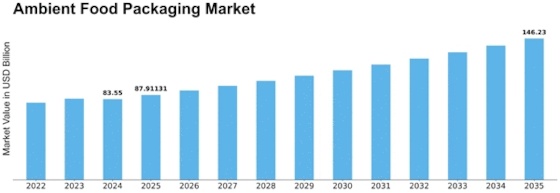

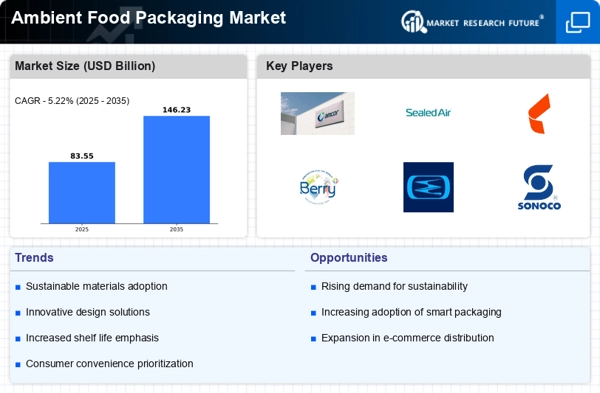
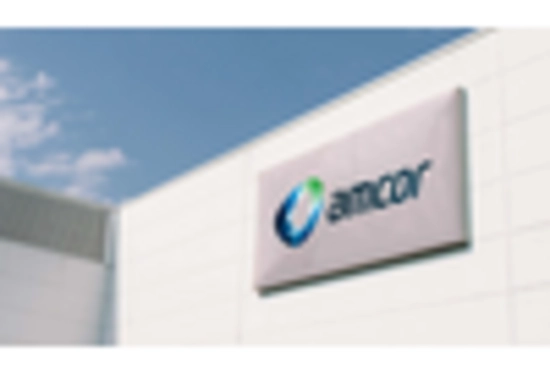
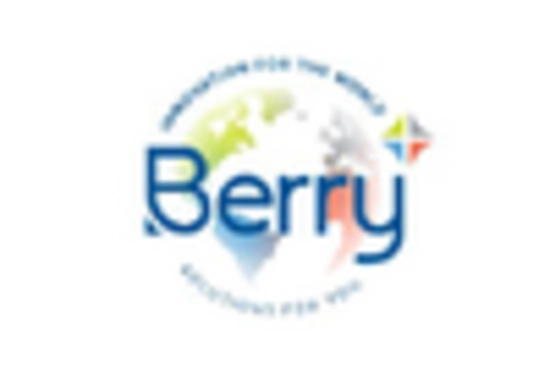

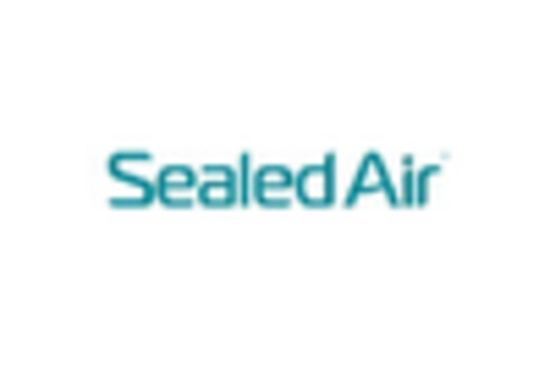

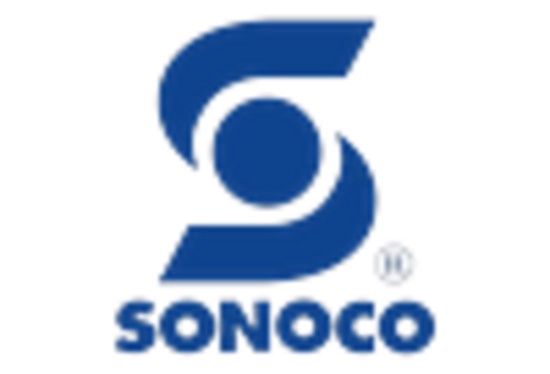

Leave a Comment